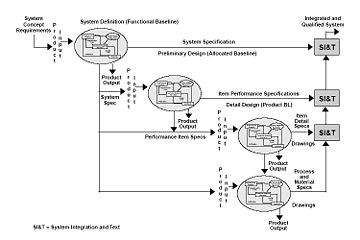Introduction to Software Engineering/Planning/Specification

A functional specification (also, functional spec, specs, functional specifications document (FSD), or Program specification) in systems engineering and software development is the documentation that describes the requested behavior of an engineering system. The documentation typically describes what is needed by the system user as well as requested properties of inputs and outputs (e.g. of the software system).
Overview
[edit | edit source]In systems engineering a specification is a document that clearly and accurately describes the essential technical requirements for items, materials, or services including the procedures by which it can be determined that the requirements have been met. Specifications help avoid duplication and inconsistencies, allow for accurate estimates of necessary work and resources, act as a negotiation and reference document for engineering changes, provide documentation of configuration, and allow for consistent communication among those responsible for the eight primary functions of Systems Engineering. They provide a precise idea of the problem to be solved so that they can efficiently design the system and estimate the cost of design alternatives. They provide guidance to testers for verification (qualification) of each technical requirement.[1]
A functional specification does not define the inner workings of the proposed system; it does not include the specification how the system function will be implemented. Instead, it focuses on what various outside agents (people using the program, computer peripherals, or other computers, for example) might "observe" when interacting with the system. A typical functional specification might state the following:
- When the user clicks the OK button, the dialog is closed and the focus is returned to the main window in the state it was in before this dialog was displayed.
Such a requirement describes an interaction between an external agent (the user) and the software system. When the user provides input to the system by clicking the OK button, the program responds (or should respond) by closing the dialog window containing the OK button.
It can be informal, in which case it can be considered as a blueprint or user manual from a developer point of view, or formal, in which case it has a definite meaning defined in mathematical or programmatic terms. In practice, most successful specifications are written to understand and fine-tune applications that were already well-developed, although safety-critical software systems are often carefully specified prior to application development. Specifications are most important for external interfaces that must remain stable.
Functional specification topics
[edit | edit source]Purpose
[edit | edit source]There are many purposes for functional specifications. One of the primary purposes on team projects is to achieve some form of team consensus on what the program is to achieve before making the more time-consuming effort of writing source code and test cases, followed by a period of debugging. Typically, such consensus is reached after one or more reviews by the stakeholders on the project at hand after having negotiated a cost-effective way to achieve the requirements the software needs to fulfill.
Process
[edit | edit source]In the ordered industrial software engineering life-cycle (waterfall model), functional specification describes what has to be implemented. The next system specification document describes how the functions will be realized using a chosen software environment. In not industrial, prototypical systems development, functional specifications are typically written after or as part of requirements analysis.
When the team agrees that functional specification consensus is reached, the functional spec is typically declared "complete" or "signed off". After this, typically the software development and testing team write source code and test cases using the functional specification as the reference. While testing is performed the behavior of the program is compared against the expected behavior as defined in the functional specification.
Types of software development specifications
[edit | edit source]- Advanced Microcontroller Bus Architecture
- Bit specification
- Design specification
- Diagnostic design specification
- Multiboot Specification
- Product design specification
- Real-time specification for Java
- Software Requirements Specification
References
[edit | edit source]- ↑ a b Systems Engineering Fundamentals. Defense Acquisition University Press, 2001
